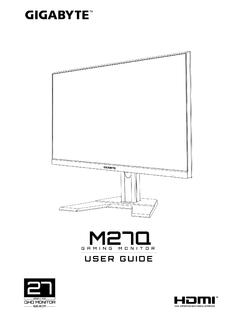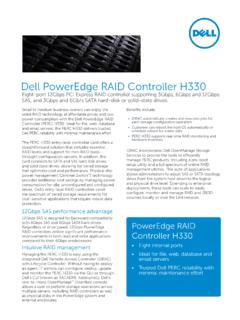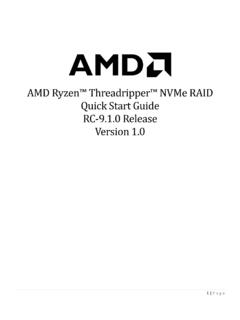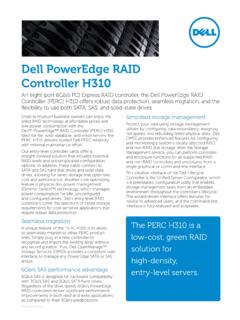Transcription of Configuring a RAID Set (Z590 Series)
1 - 1 - Configuring a RAID Set (Z590 Series) Configuring SATA Controllers ..2A. Installing hard drives ..2B. Configuring SATA controller mode in BIOS Setup ..3C. UEFI RAID Configuration ..3 Installing the RAID Driver and Operating System ..7 Installing Intel Optane Memory and Storage Management ..8A. Enabling an Intel Optane Memory ..8B. Rebuilding an Array ..10- 2 -To create a RAID set, follow the steps below:A. Install SATA hard drive(s) or SSDs in your computer. B. Configure SATA controller mode in BIOS Configure a RAID array in RAID BIOS. (Note 1)D. Install the RAID driver and operating system. Before you begin, please prepare the following items: At least two SATA hard drives or SSDs (Note 2) (to ensure optimal performance, it is recommended that you use two hard drives with identical model and capacity). (Note 3) A Windows setup disc. Motherboard driver disc or an Internet connected computer.
2 A USB thumb LevelsConfiguring SATA ControllersA. Installing hard drivesInstall the hard drives/SSDs in the Intel Chipset controlled connectors on the motherboard. Then connect the power connectors from your power supply to the hard 0 RAID 1 RAID 5 RAID 10 Minimum Number of Hard Drives 22 34 Array CapacityNumber of hard drives * Size of the smallest drive Size of the smallest drive(Number of hard drives -1) * Size of the smallest drive(Number of hard drives/2) * Size of the smallest driveFault ToleranceNoYesYesYes(Note 1) Skip this step if you do not want to create RAID array on the SATA controller .(Note 2) An PCIe SSD cannot be used to set up a RAID set either with an SATA SSD or a SATA hard drive.(Note 3) Refer to "Internal Connectors" for the installation notices for the and SATA 3 -The BIOS Setup menus described in this section may differ from the exact settings for your motherboard.
3 The actual BIOS Setup menu options you will see shall depend on the motherboard you have and the BIOS Configuring SATA controller mode in BIOS SetupMake sure to configure the SATA controller mode correctly in system BIOS 1:Turn on your computer and press <Delete> to enter BIOS Setup during the POST (Power-On Self-Test). Go to Settings\IO Ports\SATA And RST Configuration, make sure SATA controller (s) is enabled. To create RAID, set SATA Mode Selection to Intel RST Premium With Intel Optane System Acceleration. Then save the settings and restart your computer (Figure 1). Note: When using a PCIe SSD, make sure to set the RST Control PCIe Storage Devices item under Settings\IO Ports\SATA And RST Configuration to Manual. Then depending the connector you use, set the corresponding PCIe Storage Dev on Port XX item to RST Controlled. Finally, save the settings and exit BIOS 1C.
4 UEFI RAID ConfigurationStep 1:After the system reboot, enter BIOS Setup again. Then enter the Settings\IO Ports\Intel(R) Rapid Storage Technology sub-menu (Figure 2). Figure 2- 4 -Step 2:On the Intel(R) Rapid Storage Technology menu, press <Enter> on Create RAID Volume to enter the Create RAID Volume screen. Enter a volume name with 1~16 letters (letters cannot be special characters) under the Name item and press <Enter>. Then, select a RAID level (Figure 3). RAID levels supported include RAID 0, RAID 1, RAID 10, and RAID 5 (the selections available depend on the number of the hard drives being installed). Next, use the down arrow key to move to Select 3 Step 3:Under Select Disks item, select the hard drives to be included in the RAID array. Press the <Space> key on the hard drives to be selected (selected hard drives are marked with "X"). Then set the stripe block size (Figure 4).
5 The stripe block size can be set from 4 KB to 128 KB. Once you have selected the stripe block size, set the volume 4- 5 -Step 4:After setting the capacity, move to Create Volume and press <Enter> to begin. (Figure 5)Figure 5 After completing, you'll be brought back to the Intel(R) Rapid Storage Technology screen. Under RAID Volumes you can see the new RAID volume. To see more detailed information, press <Enter> on the volume to check for information on RAID level, stripe block size, array name, and array capacity, etc. (Figure 6)Figure 6- 6 -Delete RAID VolumeTo delete a RAID array, press <Enter> on the volume to be deleted on the Intel(R) Rapid Storage Technology screen. After entering the RAID VOLUME INFO screen, press <Enter> on Delete to enter the Delete screen. Press <Enter> on Yes (Figure 7).Figure 7- 7 -Installing the RAID Driver and Operating SystemWith the correct BIOS settings, you are ready to install the operating some operating systems already include RAID driver, you do not need to install separate RAID driver during the Windows installation process.
6 After the operating system is installed, we recommend that you install all required drivers from the motherboard driver disc using "Xpress Install" or from the GIGABYTE APP Center to ensure system performance and compatibility. If the operating system to be installed requires that you provide additional RAID driver during the OS installation process, please refer to the steps below:Step 1: Method 1: Copy the IRST folder under Boot in the driver disc to your USB thumb 2: Go to GIGABYTE's website, browse to the motherboard model's web page, download the Intel SATA Preinstall driver file on the Support\Download\SATA RAID/AHCI page, unzip the file and copy the files to your USB thumb 2: Boot from the Windows setup disc and perform standard OS installation steps. When the screen requesting you to load the driver appears, select 3: Insert the USB thumb drive and then browse to the location of the driver.
7 When a screen as shown in Figure 1 appears, select Intel(R) Chipset SATA/PCIe RST Premium controller and click Next to load the driver and continue the OS 1- 8 -Installing Intel Optane Memory and Storage ManagementA. Enabling an Intel Optane MemoryA-1. System Requirements1. Intel Optane memory2. The Optane memory must have at least 16 GB capacity, and it must have equal or smaller capacity than the hard drive/SSD to be accelerated. 3. The Optane memory cannot be used to accelerate an existing RAID array; the accelerated hard drive/SSD cannot be included in a RAID array. 4. The hard drive/SSD to be accelerated must be a SATA hard drive or SATA SSD. 5. The hard drive/SSD to be accelerated can be a system drive or data drive. The system drive must be GPT formatted and have Windows 10 64-bit (or later version) installed on it. The data drive must also be GPT The motherboard driver The SATA controller must set in Intel RST Premium With Intel Optane System Acceleration 1: Go to Settings\IO Ports\SATA And RST Configuration and make sure RST Control PCIe Storage Devices is set to Manual.
8 Then depending on which connector you install the Optane memory in, set the corresponding PCIe Storage Dev on Port XX item to RST 2: After re-entering the operating system, launch the Intel Optane Memory and Storage Management application from the Start menu. If you install more than one Optane memory, please select which one you are going to use. Then select which drive to be accelerated. Click Enable Intel Optane Memory. All data on the Optane memory will be erased. Make sure you back up the data before continuing. Follow the on-screen instructions to proceed. When completed, restart the Installation GuidelinesAfter entering the operating system, make sure your Internet connection works 1: Insert the motherboard driver disc into your optical drive. On the Xpress Install screen, select Intel Rapid Storage Technology to install and follow the on-screen instructions to complete the installation.
9 When completed, restart the 2: Launch the GIGABYTE APP Center. On the "Not Installed\New Drivers" screen, select Intel Rapid Storage Technology driver to install. Follow the on-screen instructions to continue. When completed, restart the 9 -Step 3: Launch the Intel Optane Memory and Storage Management application from the Start menu and make sure the Intel Optane Memory has been 4: If you want to accelerate the system drive, you can select specific folders, files, or applications to accelerate using the Intel Optane Memory Pinning function. (The Optane memory used must have at least 32 GB capacity.) An Optane memory cannot be used to accelerate an PCIe SSD. If more than one Optane memory is installed, you can select only one of them to accelerate your SATA-based boot drive. The other(s) can only be used as data drive(s). Do not abruptly remove the Optane memory.
10 Doing so will cause the operating system to stop functioning correctly. If you want to change/remove the Optane memory, you must disable it using the Intel Optane Memory and Storage Management application first. After enabling the Optane memory, the related BIOS settings will remain even after a BIOS update. - 10 -B. Rebuilding an ArrayRebuilding is the process of restoring data to a hard drive from other drives in the array. Rebuilding applies only to fault-tolerant arrays such as RAID 1, RAID 5 or RAID 10 arrays. The procedures below assume a new drive is added to replace a failed drive to rebuild a RAID 1 array. (Note: The new drive must have equal or greater capacity than the old one.)Turn off your computer and replace the failed hard drive with a new one. Restart your in the operating system, launch the Intel Optane Memory and Storage Management utility from the Start 1:Go to the Manage menu and click Rebuild to another disk in Manage Status item on the right of the screen displays the rebuild progress.














